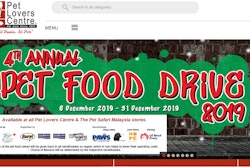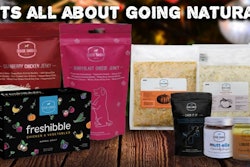
Good news for pet food: 64% of U.S. pet specialty retailers responding to Pet Product News International’s annual State of the Industry survey saw sales increases in 2018, with 26% enjoying a rise of 11% or more over 2017 figures and 8% experiencing an increase of 20% or more. (The survey was conducted in fall 2019, meaning 2018 was the most recent year with full sales data available.)
With pet food e-commerce growing so quickly and lines blurring between channels like pet specialty and mass/grocery, the pet specialty channel may no longer serve as the main lifeblood and growth driver for pet food, especially premium lines and products. Yet it still holds an important role, particularly for smaller, specialty pet food brands.
Thus, the survey respondents’ 2019 sales forecasts for their businesses is also encouraging: 64% again expect increases once this year’s sales are tallied, with 25% projecting growth of 11% or more and 10% forecasting an increase of 20% or more. Among their reasons for optimism? That customers are demanding “high-end” pet food, named by 42% of respondents. Further, 54% believe customers have a preference for local or smaller stores vs. national chain, “big box” stores, adding to their positive outlook.
Threats to pet specialty retail’s future
Yet not all is rosy for these retailers; and it’s no surprise that most perceive the largest threats to their businesses coming from e-commerce giants like Amazon (named by 66% as a competitive threat) and Chewy.com (64%), following by other pet specialty online vendors (43%) and other general, non-pet specialty online vendors (38%).
Indeed, in an accompanying analysis to the survey report, “Pet’s rapidly changing landscape,” David Lummis, lead pet market analyst for Packaged Facts, identified e-commerce as one of the key factors reshaping the industry. Accounting for 20% of pet product sales in 2019, e-commerce’s share will rise to 26% in 2023, he said, “driven in large part by Chewy and Amazon, which together account for approximately three-quarters of online sales.”
At the same time, brick-and-mortar retail’s market share is projected to decline, especially pet specialty’s, falling from 29% in 2019 to 25% in 2023, Lummis said. He added this loss is “exacerbated by the ubiquity of superpremium pet food online and in mass channels.”
The threat of big box pet specialty stores to independent pet stores may have lessened but was still named by 49% of respondents, followed by mass market big box stores other than Walmart at 37%; Walmart itself received votes from 34% of respondents. Other competitive retailers named included supermarket/grocery chains (20%), Tractor Supply and other farm/feed stores (19%), warehouse club stores (19%) and local brick-and-mortar competition (14%).
Pet food largest category, with slowing growth
In 2018, pet food accounted for 38% of the US$90.1 billion sales for the overall U.S. pet products and services industry, ahead of veterinary services (32%), pet supplies (19%) and nonmedical pet services (11%), according to Packaged Facts. Pet food’s US$34.5 billion in sales represented 4.3% year-over-year growth, Lummis said, but that rate declined from 5% growth in 2017, and slower growth is projected to continue through 2023. “During the 2018-2023 period, pet food is projected to register a compound annual growth rate of 2.6%, the lowest of the four industry classifications,” he wrote.
Lummis attributed pet food’s slower growth to e-commerce’s rise, which is “breaking down the pet specialty/mass divide and making most brands available at lower prices, through auto-replenishment programs, free shipping and convenient home delivery.” As a result, brands such as Nutro and Blue Buffalo have entered mass market channels to seek growth outside of pet specialty, he said.
The other main factor affecting pet food sales growth has been the Food and Drug Administration’s (FDA) investigation into a potential link between recent cases of canine dilated cardiomyopathy and grain-free pet food, a category that had been a sales juggernaut and growth driver for pet food. The investigation has definitely affected grain-free pet food sales and growth.
Pet population growth also slowing, but optimism abounds
Yet the “biggest drag” on the overall pet care industry, according to Lummis, is slowing growth in the U.S. pet population. While millennials have made up for some of the decline caused by aging baby boomers owning fewer pets or not replacing ones that die, that hasn’t to date been enough to appreciably improve the numbers. Thus, “advances in the number of new pets and new pet households have been minimal and are expected to slow from 1.1% for dogs and 1% for cats in 2019 to 0.9% for dogs and cats alike in 2023,” Lummis wrote.
That’s why organizations like the Human-Animal Bond Research Institute (HABRI) are so important. HABRI’s mission is to encourage and fund research proving the positive benefits of pet ownership overall and particularly to specific groups, such as children, aging seniors, people with certain illnesses and the like. To date it has funded US$3 million toward “innovative human-animal bond research projects,” according to its website; and its digital human-animal interaction library (the world’s largest, HABRI claims) holds more than 30,000 records documenting or pertaining to the human-animal bond. (If you’re looking for a pet-related organization to donate to this holiday season, you might consider HABRI.)
Indeed, pet specialty retailers and their customers seem to understand the importance of this bond; 65% of retailers responding to the State of the Industry survey voted for “heightened appreciation for the mental and physical health benefits of pet ownership” as a cause for optimism about the future of their businesses. In addition, 54% chose “heightened sense of responsibility for animal and pet welfare.”
Perhaps best of all, the reason chosen the most by these retailers for optimism, at 67%, was “customers are spending more on their pets.” Now if the industry can just encourage more people to become pet-owning customers, that should benefit everyone, including those people and their pets.

















